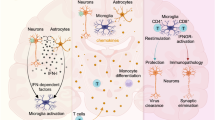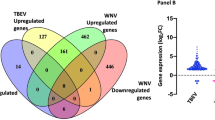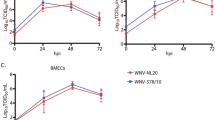Summary:
We describe here a patient who died of progressive CNS deterioration following allogeneic stem cell transplant with West Nile virus as the sole pathogen on the cerebrospinal fluid and brain tissue analysis. A 50-year-old male with Philadelphia chromosome-positive acute lymphocytic leukemia (ALL) underwent allogeneic PBSCT from his HLA identical sister. After engraftment, the patient developed fever with progressive and ultimately fatal neurological deterioration. Imaging studies of the brain including CT and MRI scans were remarkable for mild low attenuation lesions of the white matter. CSF analysis was negative for neoplastic cells, bacteria, AFB, CMV, HSV, fungal infections and leukemic relapse. However, serological analysis of both the serum and CSF was positive for West Nile virus-specific IgM antibodies. At autopsy, West Nile virus PCR and cultures were positive in the mid-brain tissue. Electron micrographs showed evidence of viral particles. Given the recent increase in the spread of West Nile virus infections and the increased susceptibility of BMT patients to infectious complications, West Nile virus encephalitis should be considered in patients undergoing transplantation.
Similar content being viewed by others
Main
West Nile virus infection is a mosquito-borne infection with a rapidly expanding geographic distribution.1 Epidemics and sporadic cases of West Nile virus disease in humans and equines have been documented in Asia, Eastern Europe and South Africa for many years. More recently, the virus was introduced to North America in 1999.1,2,3,4 Since the dramatic appearance of the epidemic of West Nile meningoencephalitis in the New York City area, the virus has subsequently spread throughout much of the Eastern and Midwestern United States, and Southern Canada.2,3,4,5 However, little is known about the significance of this viral pathogen in immunocompromised patients.
Viral encephalitis remains an important cause of CNS morbidity following hematopoietic stem cell transplantation (HSCT).6,7,8 The most commonly detected viruses are cytomegalovirus (CMV), herpes simplex virus (HSV) and HHV-6.6,7,9 However, for a minority of HSCT recipients presenting with a clinical condition indistinguishable from viral encephalitis, a viral or infectious etiology cannot be determined. We describe, to our knowledge, the first case of West Nile virus causing fatal encephalitis after allogeneic HSCT.
Case report
A 50-year-old male with a history of T3, N2, M0 rectal cancer that was treated with neoadjuvant chemoradiation therapy and surgical resection was diagnosed with pre-B-cell Philadelphia chromosome-positive acute lymphocytic leukemia (ALL). He was treated with the Larson protocol (cyclophosphamide, daunorubicin, vincristine, prednisone and L-asparaginase) and achieved a complete remission after induction.10 Following the induction phase, the patient was placed on imatinib mesylate (Gleevec) pending allogeneic bone marrow transplantation. He was admitted for transplant in the midsummer of 2002 and received an HLA-identical stem cell transplant from his sister after being conditioned with busulfan, cytarabine and cyclophosphamide.11 On day +16, after engraftment, he developed fevers with acute onset of right upper extremity weakness. CT and MRI scan of the head revealed numerous nonspecific low attenuation white matter lesions without evidence of acute infarction and hemorrhage. Owing to the possibility of tacrolimus neurotoxicity, the post engraftment immunosuppressant was switched to cyclosporine. While the patient's right upper extremity weakness improved spontaneously, he developed renal insufficiency. Cyclosporine was also discontinued and he was placed on steroids for GVHD prophylaxis. After 2 days, he developed high grade fevers and disorientation. He was started on continuous venovenous hemofiltration (CVVH) and broad-spectrum antibiotics. Repeat CT scan of the head did not reveal any new changes. Examination of the cerebrospinal fluid demonstrated a protein of 123 mg/dl, glucose of 64 mg/dl, 1 RBC/cmm and 17 WBC/cmm, with a differential of 5% neutrophils, 62% lymphocytes and 33% histiocytes. Cytological examination as well as flow cytometry of the CSF was negative for leukemic relapse. CSF was also negative for bacteria, HSV, CMV, AFB and fungal infections. The patient's mental status changes progressed, and he became unresponsive and was once again intubated for airway protection. Repeat CT and MRI scans did not show any new changes. A repeat lumbar puncture CSF as well the serum was sent to the Michigan Department of Public Health for a West Nile virus assay. Serological analysis of both the serum and CSF was positive for West Nile virus-specific IgM antibodies. A presumptive diagnosis of West Nile virus meningoencephalitis was made. Over the course of the next few weeks, the patient showed no neurological improvement and expired.
In the period from admission for transplantation to the development of symptoms suggestive of encephalitis, the patient received 77 blood components (seven RBCs and 70 platelet concentrates) and the stem cell donation. All donations occurred in southeastern Michigan during the summer of 2002. The stem cells were negative for WN virus RNA. In all, 68 of the transfused components had a co-component or retained segment recovered. All were tested and negative for WN virus RNA and WN IgM antibody. Three other donors subsequently donated again and were WN virus IgM negative. Thus, six of the blood products administered to this patient after BMT were of undetermined status for West Nile virus. These were transfused 13 days (two platelet concentrates), 9 days (RBCs), 6 days (platelet concentrate), 5 days (RBCs) and 0 days (platelet concentrate) before the onset of encephalitis.
At autopsy, the brain weighed 1520 g with attenuation of the sulci and gyral flattening. Grossly, there were multiple prominent white matter small vessels with perivascular gray rimming. Microscopically, sections of the cortex, basal ganglia, hippocampus and midbrain showed microglial nodules (Figure 1a and b), diffuse white matter perivascular lymphocyte and macrophage cuffing, as well as neuronophagia (Figure 2a and b). These lesions were most prominent in the frontal cortex, midbrain and medulla, but were also present in the cerebellum, pons and lentiform nuclei. Occasional neurons contained numerous discrete round basophilic inclusion bodies. These pathologic findings are similar to those reported previously in community-acquired WNV infection.12,13
Electron microscopy on the midbrain demonstrated viral particles (Figure 3a and b). West Nile virus PCR and culture was positive in the midbrain tissue, indeterminate in the brain medulla and cortex, but was negative in the kidneys, myocardium and liver.
Discussion
Neurological complications after allogeneic BMT can occur due to a variety of causes.6,14,15,16 A retrospective study showed that 37% of allogeneic BMT patients developed neurological symptoms and the most frequent cause was the use of immunosuppressive drugs.8 However, cerebrovascular events and CNS infections resulted in the most severe complications.6,8 A recent prospective study of 71 allogeneic bone marrow recipients showed that acute CNS complications occurred in 18% of the patients and led to death in 9% of the study population.14 This patient presented with an upper extremity weakness that was spontaneously resolving when he developed a prodrome of high-grade fever mental status changes that progressed to coma and eventually led to death. Microbiological investigations for bacteria and viruses of the blood and CSF were negative, save for the positive serology for West Nile virus infection. Furthermore autopsy showed evidence of the West Nile virus in the brain tissue demonstrating that the progressive CNS failure was secondary to West Nile virus meningoencephalitis.
Since its first isolation in 1937, large epidemics of WN virus have been described in Israel, South Africa, Europe and more recently in North America.1,2,3,4,17,18,19 During the last 3 years, WN virus extended its range in North America throughout much of the eastern parts of the USA and from the Atlantic coast to eastern North Dakota.2,3,5,20,21,22 The virus has also been detected in south-central Canada.2,3 WN virus is a single-stranded RNA arbovirus that is maintained in nature in a mosquito–bird–mosquito transmission cycle primarily involving Culex sp mosquitoes, but can also be transmitted via blood products.23 The virus has also been isolated from 29 mosquito species belonging to 10 genera in the USA alone.3,5,22,23 A broad range of mammalian species are susceptible to natural or experimental infection with WN virus, but naturally acquired disease in mammals has been conclusively demonstrated in human beings and equines only.22,23
In the US, as in our patient, most cases of WN virus infections occur in summer or fall, coinciding with the seasons for mosquito infection.1,2,3,5,22,23 Even though most WN viral infections are asymptomatic, the incubation period is approximately 2–14 days in cases of symptomatic infections.1,23 This patient was on the Bone Marrow Transplant unit continuously for 4 weeks before the onset of encephalitis. There was no opportunity for mosquito exposure during this time. Although we cannot conclusively define the source of the WN viral infection, he did receive six blood products within 13 days of the onset of encephalitis that could have contained WN virus. These blood products were donated during the peak of WN virus activity in southeastern Michigan in 2002. Other described routes of WN virus transmission include transplacental, breast milk and organ transplantation, all of which can be excluded in this case.1,5,23 Proximate to this case, several other cases of transfusion-transmitted West Nile infection were reported, including two from Michigan.24 In these cases, RBCs, platelet concentrates and fresh frozen plasma were implicated in viral transmission. In addition, cases of WNV infection in solid organ transplantation have also been recently reported.25
The WN virus-associated clinical syndromes are nonspecific and a diagnosis cannot reliably be made on clinical grounds alone. However, the incidence of encephalitis increases with age.26 Clinically, WN encephalitis is similar to other arboviral encephalitides, that is, a prodrome of fever and headache accompanied by mental status changes.2,23 However, in only 15% of cases did cerebral dysfunction progress to coma, as was seen in our patient.1,5,23 In patients with WN encephalitis, imaging studies and routine CSF analysis do not show features that are diagnostic for this disease. Serology is the most important laboratory test for diagnosis of WN viral infections.23 A recent presumptive WN viral infection can be inferred by the detection of IgM in serum or CSF – but duration of IgM antibody in CSF, or in the serum of patients without meningoencephalitis, is unknown.27,28 The mortality rate of WN meningoencephalitis is 4–14%.23 The rates are higher in older patients.1 However, as demonstrated by our case, immunocompromised transplant patients might also be at a higher risk for developing fatal meningoencephalitis.
The appropriate degree of clinical suspicion, screening of blood products and the development of more rapid and widely available diagnostic tests may be critical for the prevention and early diagnosis to initiate timely supportive care. The FDA has released guidance on the assessment of blood donors to reduce the risk of transfusion-transmitted West Nile infections (Guidance for Industry: Revised Recommendations for the Assessment of Donor Suitability and Blood and Blood Product Safety in Cases of Known or Suspected West Nile Virus Infection – 5/1/2003). The FDA also recommends that transfusion services consider notification of treating physicians of prior recipients of blood and blood components collected from donors diagnosed with West Nile Virus infection. Presently, there is no FDA-approved test for screening of blood donors for West Nile virus; however, tests for detection are being evaluated. The Committee felt that when donor testing is available, it should apply uniformly to all blood donations, regardless of geographic location or seasonality. Given the expanding geographic range of West Nile virus, it should be considered in the differential diagnosis of encephalitis in patients after allogeneic transplantation.
References
Petersen LR, Marfin AA . West Nile virus: a primer for the clinician. Ann Intern Med 2002; 137: 173–179.
Johnson RT . West Nile virus in the US and abroad. Curr Clin Top Infect Dis 2002; 22: 52–60.
O'Leary DR, Nasci RS, Campbell GL, Marfin AA . From the Centers for Disease Control and Prevention West Nile Virus activity – United States, 2001. JAMA 2002; 288: 158–159, (discussion 159–160).
From the Centers for Disease Control and Prevention. Update: West Nile virus encephalitis – New York, 1999. JAMA 1999; 282: 1806–1807.
From the Centers for Disease Control and Prevention. Provisional surveillance summary of the West Nile virus epidemic – United States, January–November 2002. JAMA 2003; 289: 293–294.
Maschke M, Dietrich U, Prumbaum M et al. Opportunistic CNS infection after bone marrow transplantation. Bone Marrow Transplant 1999; 23: 1167–1176.
Julin JE, van Burik JH, Krivit W et al. Ganciclovir-resistant cytomegalovirus encephalitis in a bone marrow transplant recipient. Transplant Infect Dis 2002; 4: 201–206.
Gallardo D, Ferra C, Berlanga JJ et al. Neurologic complications after allogeneic bone marrow transplantation. Bone Marrow Transplant 1996; 18: 1135–1139.
Tauro S, Toh V, Osman H, Mahendra P . Varicella zoster meningoencephalitis following treatment for dermatomal zoster in an alloBMT patient. Bone Marrow Transplant 2000; 26: 795–796.
Larson RA, Dodge RK, Burns CP et al. A five-drug remission induction regimen with intensive consolidation for adults with acute lymphoblastic leukemia: cancer and leukemia group B study 8811. Blood 1995; 85: 2025–2037.
Ratanatharathorn V, Karanes C, Lum L et al. Allogeneic bone marrow transplantation in high-risk myeloid disorders using busulfan, cytosine arabinoside and cyclophosphamide (BAC). Bone Marrow Transplant 1992; 9: 49–55.
Kelley TW, Prayson RA, Ruiz AI, Isada CM, Gordon SM . The neuropathology of West Nile virus meningoencephalitis. A report of two cases and review of the literature. Am J Clin Pathol 2003; 119: 749–753.
Shieh WJ, Guarner J, Layton M et al. The role of pathology in an investigation of an outbreak of West Nile encephalitis in New York, 1999. Emerg Infect Dis 2000; 6: 370–372.
Sostak P, Padovan CS, Yousry TA et al. Prospective evaluation of neurological complications after allogeneic bone marrow transplantation. Neurology 2003; 60: 842–848.
Padovan CS, Gerbitz A, Sostak P et al. Cerebral involvement in graft-versus-host disease after murine bone marrow transplantation. Neurology 2001; 56: 1106–1108.
Re D, Bamborschke S, Feiden W et al. Progressive multifocal leukoencephalopathy after autologous bone marrow transplantation and alpha-interferon immunotherapy. Bone Marrow Transplant 1999; 23: 295–298.
Giladi M, Metzkor-Cotter E, Martin DA et al. West Nile encephalitis in Israel, 1999: the New York connection. Emerg Infect Dis 2001; 7: 659–661.
Tsai TF, Popovici F, Cernescu C, Campbell GL, Nedelcu NI . West Nile encephalitis epidemic in southeastern Romania. Lancet 1998; 352: 767–771.
Lundstrom JO . Mosquito-borne viruses in western Europe: a review. J Vector Ecol 1999; 24: 1–39.
Marfin AA, Petersen LR, Eidson M et al. Widespread West Nile virus activity, eastern United States, 2000. Emerg Infect Dis 2001; 7: 730–735.
Mostashari F, Bunning ML, Kitsutani PT et al. Epidemic West Nile encephalitis, New York, 1999: results of a household-based seroepidemiological survey. Lancet 2001; 358: 261–264.
Nedry M, Mahon CR . West Nile virus: an emerging virus in North America. Clin Lab Sci 2003; 16: 43–49.
Campbell GL, Marfin AA, Lanciotti RS, Gubler DJ . West Nile virus. Lancet Infect Dis 2002; 2: 519–529.
Update:. Investigations of West Nile virus infections in recipients of organ transplantation and blood transfusion – Michigan, 2002. MMWR Morb Mortal Weekly Rep 2002; 51: 879.
Iwamoto M, Jernigan DB, Guasch A et al. Transmission of West Nile virus from an organ donor to four transplant recipients. N Engl J Med 2003; 348: 2196–2203.
Han LL, Popovici F, Alexander Jr JP et al. Risk factors for West Nile virus infection and meningoencephalitis, Romania, 1996. J Infect Dis 1999; 179: 230–233.
Roehrig JT, Nash D, Maldin B et al. Persistence of virus-reactive serum immunoglobulin m antibody in confirmed West Nile virus encephalitis cases. Emerg Infect Dis 2003; 9: 376–379.
Campbell GL, Grady LJ, Huang C et al. Laboratory testing for West Nile virus: panel discussion. Ann NY Acad Sci 2001; 951: 179–194.
Author information
Authors and Affiliations
Corresponding author
Rights and permissions
About this article
Cite this article
Reddy, P., Davenport, R., Ratanatharathorn, V. et al. West Nile virus encephalitis causing fatal CNS toxicity after hematopoietic stem cell transplantation. Bone Marrow Transplant 33, 109–112 (2004). https://doi.org/10.1038/sj.bmt.1704293
Received:
Accepted:
Published:
Issue date:
DOI: https://doi.org/10.1038/sj.bmt.1704293
Keywords
This article is cited by
-
Opportunistic Infections of the Central Nervous System in the Transplant Patient
Current Neurology and Neuroscience Reports (2013)
-
West Nile Virus Infection in the Immunocompromised Patient
Current Infectious Disease Reports (2013)
-
West Nile Virus encephalopathy in an allogeneic stem cell transplant recipient: use of quantitative PCR for diagnosis and assessment of viral clearance
Bone Marrow Transplantation (2005)






